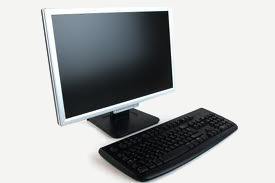
Most computers store data on one or more 3.5” desktop-sized hard drives. Desktop hard drives are physically larger than laptop hard drives and can generally store more data. They also consume more power and may me more susceptible to certain types of failure.
Desktop hard drives aren’t built to withstand physical shocks and a drop or even regular exposure to vibration could cause a desktop drive to fail. Power surges can also damage a desktop hard drive’s delicate electronics, especially if a desktop isn’t hooked up to any type of surge protector or power supply.
Types of Desktop Hard Drives
There are several types of desktop hard drives, including SATA, IDE, EIDE, and SCSI. These are interfaces that the hard drive uses to communicate with a computer. There are also dozens of hard drive manufacturers, although the number of HDD brands has shrunk significantly in the last several years as hard drive technology has become more complex and difficult to reproduce.
At BounceBack Data Recovery, we have experience with every type of brand of desktop HDD. Some of the hard drive brands that we evaluate and recover on an everyday basis include Seagate, Maxtor, IBM, Western Digital and Samsung.
Desktop Hard Drive Data Recovery Techniques
We evaluate every desktop hard drive before recovery and use the latest safe methods to get a copy of each HDD including head replacement, platter transfers and other highly specialized techniques. Many of these techniques require the use of our class 100 clean room to prevent hard drive platter contamination, which significantly lowers the chances of recovery.
Here are a few tips to improve the chances of a successful data recovery:
- Always get a professional evaluation before proceeding with data recovery services. BounceBack Data Recovery offers a free evaluation.
- Never operate a desktop hard drive that’s making noise or showing any of the other symptoms of physical failure. Turn a malfunctioning hard drive off immediately to avoid platter damage, which can occur after the hard drive’s read/write heads come in contact with its platters.
- Always safely package a desktop hard drive with a minimum 5 inches of packing material before shipping it.
- Never run data recovery software on a physically damaged hard drive
Our data recovery technicians and customer service specialists provide top-of-line service to our desktop data recovery customers. They have years of experience recovering lost or damaged data from desktops and are able to put that experience to work for you. You will have peace of mind knowing that our business has two levels of ISO certification and all data is recovered in a Class 100 certified clean room.
For more information about our desktop hard drive data recovery services, contact us today or use our online case setup form to arrange a free evaluation.
